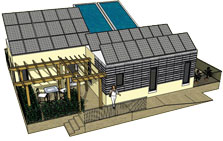

The Santa Clara team calls their project the "Ripple Home," because it is designed to educate and encourage the widespread adoption of sustainability and solar energy through the "ripple effect" of education.
Download Construction Drawings
(Zip 14 MB)
Neither the United States, nor the Department of Energy, nor the Alliance for Sustainable Energy LLC, nor any of their contractors, subcontractors, or their employees make any warranty, express or implied, or assume any legal liability or responsibility for the accuracy, completeness, or usefulness for any purpose of any technical resources or data attached or otherwise presented here as reference material.
Solar Decathlon 2007
Santa Clara University
Purpose Drives Innovation, Gratitude Inspires Giving Back
Design with purpose. This succinct philosophy guided the Santa Clara University team in its quest to build a sustainable solar house that is functional, elegant, intelligent, and innovative.
"Our house is dynamically smart. Its computers sense interior and exterior conditions and make automatic adjustments for thermal comfort and efficient energy usage," says Team Manager James Bickford.
It's not surprising that students from Silicon Valley would take this approach to operating their innovative house—starting with the electrochromic windows. With a flip of a switch, the glass darkens to block sunlight or lightens to let it in, depending on the temperature desired inside the house. Another innovation is a prototype solar thermal unit (with absorption chillers) for space and water heating as well as air-conditioning.
The house was built to operate off the utility grid using the PV modules with backup batteries during the Solar Decathlon event. However, when it returns to campus, the house can easily be connected to the grid using an appropriate inverter, and its excess power sold to the utility provider.
To measure and certify the house's sustainability, the team uses a unique meter that quantifies the power used for heating and cooling and measures the amount of carbon emissions the house saves. In the future, this meter could be instrumental in the selling of carbon credits to carbon emitters, which could motivate people to save energy and accumulate carbon credits that can be turned into cash.
Purpose drives the Santa Clara students to innovate, and gratitude inspires them to share their knowledge with the community. "Our community has given us enormous support," says Communications Director Meghan Mooney. "We wanted to give back, so we organized a mini solar decathlon competition among three local high schools." The event resulted in greener schools and a heightened awareness of the environment and the importance of sustainability.
Team Contact
Jorge E. Gonzales
jgonzalezcruz@scu.edu
